Celebrating World Architecture

ISTANBUL architectural office Tabanlioglu Architects bagged the top prize for the Transport category with their design for the Bodrum Airport in Turkey. Photo courtesy of Dezeen
A FEW weeks ago, I headed to Singapore to attend the World Architecture Festival. Touted by some as the “Oscars” of the international architecture and design industry, the WAF hosts a global design competition for 37 project categories including awards for “Future project of the Year,” “Landscape of the Year” and “World Building of the Year.” WAF is quite the melting pot, with design professionals coming together to share the many diverse concepts and ideas in the creation of what is, to their own unique definition, good architecture. The many design approaches from the various corners of the world make the festival a showcase of style and creativity.
First time in Asia
The festivals were always held in Barcelona since they started in 2008. Unfortunately, the hectic work pace approaching our holiday season has kept me from traveling toward that direction in November, when the festival is annually celebrated. This year was the first time it was held in Asia, and Singapore was a fitting destination for an event that dealt with forward-looking ideas and sensitivities to the built environment. It was an easier venue to run off to as well, and so I skipped five days of work to immerse myself in the wonderful world of global design.
The event kicked off with a “Pecha Kucha” night, a series of presentations done in the “Pecha Kucha” style: 20 slides shown for 20 seconds each (6 minutes and 20 seconds in total). Tokyo-based architects Astrid Klein and Mark Dytham designed Pecha Kucha specifically so that architects and designers learn to present in a precise, concise and quick manner, rather than bore their audience to death—which is the tendency of most creatives who grapple with words as they try to concretize visual concepts. Pecha Kucha has evolved into party nights where presenters—mostly people from the creative field—show and explain their work within a festive atmosphere. It’s what we enjoyed on opening night: five presentations and party.
That same evening, I had a really good time chatting with architecture students, young men from Sicily and Liverpool who had pitched entries in the student category. In the days that came, they spent long hours deliberating with panels of architects, going to and fro their drawing tables to crank out and refine their plates into “real” architecture. It was a true mentoring experience, something I could have only dreamt of while still in architecture school.
Interesting discussions
The days that followed were of endless hours spent watching presentations: there were as many as six crit rooms where projects were simultaneously being shown and discussed (much like a thesis deliberation) by their architects and the judges. I enjoyed moving around the rooms but stayed lengthily during the more interesting discussions. I sat through a multi-use stadium, a three-level home constructed from container vans, a library in a small town just off Beijing and a school in Vietnam that was built on a tight budget yet with a very contemporary and functional design approach.
Aside from these crit rooms, there was the huge Festival Hall where celebrated architects gave talks, deliberated, and threw out ideas and relevant concepts on prevailing issues relating to global design, sustainability, the threat of recession and the changing demographics of the global community. On the last two days, winners of the various categories presented their projects.
I very much enjoyed the presentation of Catalan architect Enric Ruiz-Geli, who has been working on the design for the creative center of Spanish chef Ferran Adria’s El Bulli Foundation, a place “where chefs can create, discuss and interact with other researchers like journalists, scientists and philosophers.”
Ruiz-Geli’s work (including the “Thirst Pavilion” installation for the 2012 Venice architecture biennale) appears to be science and fiction rolled together. For the El Bulli Foundation, he explained his design on “molecular” terms (aligning with the culinary techniques of his chef client), and of its forms emanating from the molecules of the salt air, the trees, the sunlight. His concepts sound as eccentric and mind-boggling as his previous designs, but yes, they have been built, and have won awards and are quite the icons for design and technological exploration.
‘Paper architect’
I was thrilled to see and listen to Sir Peter Cook, a practicing architect, distinguished member of the British academe and a writer of many books on architecture. Like Zaha Hadid, he was tagged a “paper architect” in the 1980s, a title that was both disconcerting and gratifying, for his designs were beyond their time, and the technology then could not build it. He was knighted in 2007 for his contributions to architecture and education.
My only disappointment with this year’s festival is that it did not run its interior track, the “Inside” which hosts the interior design competition. WAF 2013 should be more exciting with the return of Inside.
Nonetheless, the talks and the more than 300 architectural entries on display at the Festival Hall held enough thrill and substance to make being there all worth it. I came back home exhausted yet inspired. Design and creativity is borne out of the capacity to express abstractions, and build them into reality for people to enjoy. We saw them all at the WAF! Architecture and design are alive and well in every corner of the world.
Contact the author through [email protected] or through our Asuncion Berenguer Facebook account.














